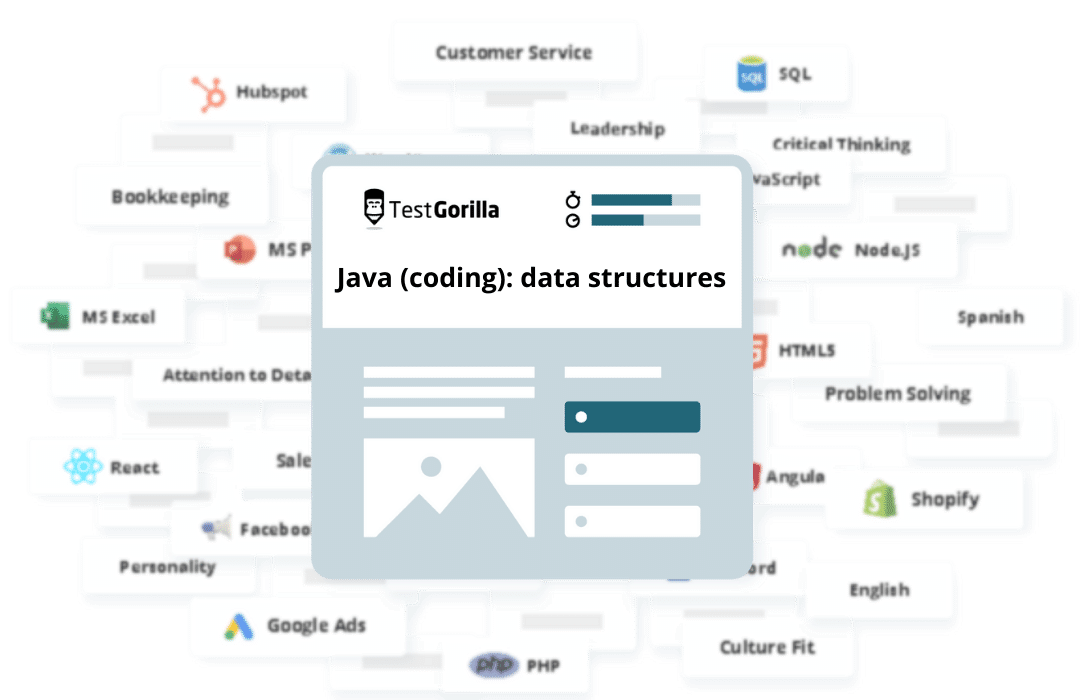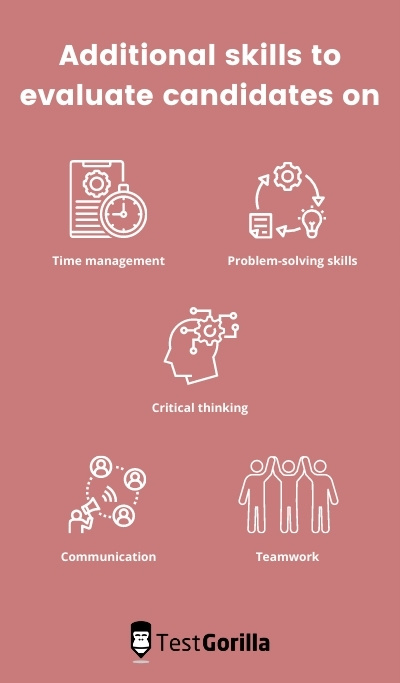Java data structures test: Online screening assessment to hire the best candidates
Summary of the Java (coding): data structures test
This Java data structures test assesses a candidate’s ability to effectively manipulate core data structures in the Java programming language. In 30 minutes, they will work with the core Java API to implement typical and real-life scenarios.
Covered skills
Data structures
Use the Java (coding): data structures test to hire
Any developer who is expected to have practical experience using Java. The difficulty level of these questions is geared to mid-level developers.
Type
Time
Languages
Level
About the Java (coding): data structures test
Java is a general-purpose language used for distributed environments. It is one of the most popular programming languages for Android app development, embedded systems, desktop applications, and enterprise-grade systems.
Working with data structures is crucial to the success of a developer. Effective utilization of the core Java API and data structures enables developers to effectively organize, manage, and represent data. Data structures are often implemented as objects, so the ability to effectively work with objects and understanding object-oriented programming is an important skill to have.
This coding test presents a real-life scenario to your candidates. They have 30 minutes to implement a data structure that meets the given requirements. Candidates can run the code against a selected number of test cases to see if they are on track. After submission, the code is automatically scored based on another set of test cases that also covers exceptions or corner cases. You will be able to play back how the code came about in the coding editor.
We recommend combining coding tests with one of our cognitive ability tests.
The test is made by a subject-matter expert
Victoria S.
Victoria is a Senior/TL Java Developer with over 10 years of experience in software development, known for her creativity and passion for her work and clients. She has deep experience in requirement analysis, project designing and implementation, team management, analysis of customer issues, code refactoring, and optimization.
Crafted with expert knowledge
TestGorilla’s tests are created by subject matter experts. We assess potential subject-matter experts based on their knowledge, ability, and reputation. Before being published, each test is peer-reviewed by another expert, then calibrated using hundreds of test takers with relevant experience in the subject. Our feedback mechanisms and unique algorithms allow our subject-matter experts to constantly improve their tests.
What our customers are saying
TestGorilla helps me to assess engineers rapidly. Creating assessments for different positions is easy due to pre-existing templates. You can create an assessment in less than 2 minutes. The interface is intuitive and it’s easy to visualize results per assessment.
David Felipe C.
VP of Engineering, Mid-Market (51-1000 emp.)

Any tool can have functions—bells and whistles. Not every tool comes armed with staff passionate about making the user experience positive.
The TestGorilla team only offers useful insights to user challenges, they engage in conversation.
For instance, I recently asked a question about a Python test I intended to implement. Instead of receiving “oh, that test would work perfectly for your solution,” or, “at this time we’re thinking about implementing a solution that may or may not…” I received a direct and straightforward answer with additional thoughts to help shape the solution.
I hope that TestGorilla realizes the value proposition in their work is not only the platform but the type of support that’s provided.
For a bit of context—I am a diversity recruiter trying to create a platform that removes bias from the hiring process and encourages the discovery of new and unseen talent.
David B.
Chief Talent Connector, Small-Business (50 or fewer emp.)

Use TestGorilla to hire the best faster, easier and bias-free
Our screening tests identify the best candidates and make your hiring decisions faster, easier, and bias-free.
Watch what TestGorilla can do for you
Create high-quality assessments, fast
Building assessments is a breeze with TestGorilla. Get started with these simple steps.
View a sample report
The Java (coding): data structures test will be included in a PDF report along with the other tests from your assessment. You can easily download and share this report with colleagues and candidates.
The importance of data structures in Java
With data demands for applications and programs constantly increasing, so too does the need for candidates with strong competencies in data structuring. This is simply because data structures are the core of any programming language. They are used in almost every aspect of computer science, including operating systems, artificial intelligence, and graphics processing.
In Java, data structures describe the logical organization of data and involve using algorithms to store data in a way that is easy and efficient to retrieve and use. In its essence, a data structure is a data collection with well-defined operations, behavior, or properties.
Humans use this concept to better visualize and understand how data is stored and retrieved. Therefore, it is important that Java developers understand how to use appropriate data structures that will improve an application’s performance.
Data structuring challenges in business
Alongside algorithms, data structures have become one of the most important disciplines in computer science. As data volume increases rapidly and applications become more complex, there is an increased need for effective data structures. In addition, data structures provide an efficient way to store data for future access.
This means that developers need to know how to effectively use the core Java API and data structures to organize, manage, and represent data. To achieve this, developers must have familiarity with the common operations in data structures, which include:
• Access: Storing data for future access based on the requirement• Searching: Finding any element within data structures• Sorting: Arranging data into ascending or descending order• Insertion: Adding new elements into a data structure• Updating: Replacing an element with a different or new version of an element• Deletion: Removing an element
Considerations for developers
In development, there are three primary considerations that influence effective memory organization. These are:
• Efficiency: The efficiency of data structures is related to the amount of data an algorithm must process. To increase the efficiency and performance of applications, data is organized in a way that requires less space but processes at a higher speed and thus also requires less time.
• Reusability: Data-structures reusability looks at the implementation of particular data structures that can be reused and replicated multiple times. The implementation of reusability in data structures allows the variable application of these libraries.
• Abstraction: In Java, the Abstract Data Types, or ADT, specify data structures. This means the client program uses the specified data structures with the help of only the interface, without needing to know any of the implementation’s details.
Having solid knowledge of the types of data structures is essential for all Java developers because it forms a fundamental part of the language. By determining if candidates have the necessary knowledge and skills to effectively implement data structures and understand the use of the different types of data structures, recruiters can easily hire the best person for the job. But how do you determine candidates’ skills? Let’s show you.
How to recruit developers with data structures knowledge
Candidates with good knowledge of data structures are able to write code that is efficient and reliable. They will be capable of solving development problems quickly and effectively. One way to determine if job applicants have the data-structures skills required for the position is by giving them a Java coding test.
Skills testing evaluates all your candidates on the same parameters, allowing you to quantify their individual expertise in the skills that are the most valuable to the open role. Additionally, skills testing allows you to rank applicants on the same scale. This helps you compare candidates and understand which individuals excel in which areas.
The benefits of pre-employment testing with a Java (Coding) Data Structures test
In recent years, skills testing has become a more popular way to recruit, because CVs don’t give recruiters and hiring managers adequate information on candidate skills. Skills testing helps you:
• Spend less time on unqualified candidates: Pre-employment testing helps you easily filter out unsuitable candidates and focus on the applicants that possess the necessary skills for the role.
• Improve your time to hire: By testing job applicants at the start of your recruitment process, you can review, rank, and sort candidates to help you focus on only the most qualified individuals.
• Reduce recruitment costs: By focusing on only the most skilled candidates, and improving your time to hire, you can reduce recruitment costs and make fewer mis-hires.
• Deliver an outstanding candidate experience: Applicants can take skills tests on any device, anywhere in the world. By recruiting with skills tests, applicants know that they will be judged solely on their skills and abilities.
• Test applicants regardless of experience level: One of the benefits of pre-employment testing is its ability to test candidates for a variety of job roles and levels of seniority.
• Validate candidates’ skills before interviewing: Pre-employment testing helps you to narrow down your selection of applicants and only interview the most qualified ones. In addition, testing enables you to learn more about candidates, which can help you in the interview process.
In summary
Using TestGorilla, you can evaluate job applicants and gain additional insights into their skills at the start of the recruitment process. Our pre-employment tests like the Java (Coding) Data Structures test help you streamline your recruitment process, eliminate unconscious bias, and identify the best candidates to interview.
By adding the Java (Coding) Data Structures test to your pre-employment assessment, you can test candidates on the technical skills needed for the job. You can also add tests that evaluate applicants on soft skills, culture add, and personality to give you an in-depth overview of each candidate’s skills and help you see how they would fit into the role.
In addition, TestGorilla can integrate with leading applicant tracking systems (ATS), enabling you to manage recruitment in one system. This helps you simplify your hiring process without having to ask applicants to create additional accounts to complete the assessments.
Start hiring smarter, faster, and bias-free with TestGorilla today!
FAQs
Related tests
Advanced networking in Amazon Web Services (AWS)
Symfony
Erlang (coding) Entry-Level Algorithms test
Dart (coding) Intermediate-Level Algorithms test
Erlang (coding) Intermediate-Level Algorithms test
Rust (coding): Data Structures - Arrays test
Perl (coding): Data Structures - Arrays test
Rust (coding) Intermediate-Level Algorithms test
Perl (coding) Intermediate-Level Algorithms test
Erlang (coding): Data Structures - Arrays test












